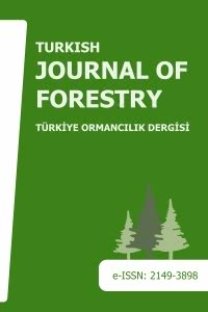Orman ağaçlarında eşleşme şekilleri
Orman ağaçlarında yaşayabilir nitelikteki tohumlar başlıca üç farklı tipteki döllenme (eşleşme) sonucu oluşur: kendi-kendine döllenme, aynı lokal populasyon içinde farklı bireyler arasındaki döllenme ve lokal populasyon dışındaki bireylerden gelen polenlerle döllenmedir. Kozalaklı orman ağacı (konifer) türlerinde eşleşme şekli konusunda yapılan çalışmalar son yıllarda hızla artmaktadır. Klonal tohum bahçelerinde kendinden-başka-bireylerle döllenme sonucu oluşan tohumların yarısından fazlası tohum bahçesi dışındaki bireylerden gelen polenler (yabancı gen akımı) sonucu oluşmaktadır. Doğal populasyonlarda ise oluşan tohumların, ne oranda kendi-kendine döllenme sonucu, ne oranda aynı populasyon içindeki farklı bireyler arasındaki döllenme sonucu, ne oranda gen akımı sonucu oluştuğu konusunda yeterli bilgi bulunmamaktadır. Bu makalede, koniferlerde eşleşme modelleri ve eşleşme sistemiyle ilgili parametrelerin, genetik markırlar (belirteçler) yardımıyla belirlenmesi konusunda bilgiler verilmektedir.
Anahtar Kelimeler:
izoenzimler, orman ağaçları, gen akışı
Mating patterns in forest trees
Viable seeds in a population of forest trees result from three types of fertilization: selfing, outcrossing among different individuals within the same local population, and outcrossing with the mates outside the local population. Research on mating patterns in forest trees has been accelerated in recent years. In clonal seed orchards, more than half of cross-fertilized seeds are due to pollens coming from outside sources (gene flow). In natural populations, however, there is no enough information as to the proportions of viable seeds resulting from either selfing, cross-fertilization among different individuals within a local population, or foreign gene flow. This article presents information on how mating patterns and related parameters in conifer species could be determined through genetic markers.
Keywords:
isoenzymes, forest trees, gene flow,
___
Adams, W.T., 1992. Gene dispersal within forest tree populations. New Forest, 6:217-240.Adams, W.T. and Birkes, D.S., 1989. Mating patterns in seed orchards. In: Proceedings of 20th Southern Forest tree Improvement Conference, June 26-30, 1989, Charleston, South Carolina.
Adams, W.T. and Birkes, D.S., 1991. Estimating mating patterns in Forest tree populations. In: Fineschi, S., Malvoltti, M.E., Cannata, F. and Hattemer, H.H. (Editors) Biochemical Markers in the Population Genetics of Forest Trees. SPB Academic Publishing bv, The Hague, The Netherlands. pp. 157-172.
Adams, W.T., Birkes, D.S. and Erickson, V.J., 1992. Using genetic markers to measure gene flow and pollen dispersal in forest tree seed orchards. In: R. Wyatt (ed.), Ecology and Evolution of Plant Reproduction. pp. 37-61.
Adams, W.T. and Joly, R.J., 1980. Allozyme studies in loblolly pine seed orchards: Clonal variation and frequency of progeny due to self-fertilization. Silvae Genet., 29:1-4.
Brown, A.D.H., Barrett, SC.H. and Moran, G.F., 1985. Mating system estimation in forest trees:models, methods, meanings. In:Gregorius, H.-R. (Ed.), Population Genetics in Forestry, pp:32-49. Lecture Notes in Biomathematics 60. Springer- Verlag, New York.
Burczyk, J., 1996. Variance effective population size based on multilocus gamete frequencies in coniferous population: an example of a scots pine clonal seed orchard. Heredity, 77: 74-82.
Burczyk, J., 1998. Mating system variation in Scots pine clonal seed orchard. Silvae Genet., 47(2-3): 155-158.
Burczyk, J. and Prat, D., 1997. Male reproductive success in Pseudotsuga menziesii(Mirb.) Franco: the effects of spatial structure and flowering characteristics. Heredity, 79:638-647.
Burczyk, J., Adams, W.T. and Shimizu, J. Y., 1997. Mating system and Genetic diversity in natural populations of knobcone pine (Pinus attenuata). Forest Genet., 4(4):223-226.
Clegg, M. T., 1980. Measuring Plant Mating Systems. Bioscience, 30(12):814-818. EL-Kassaby, Y.A. and Jaquısh, S., 1996. Population density and Mating pattern in Western Larch. J. Hered., 87:438-443.
EL-Kassaby, Y.A. and Rıtland, K., 1986. Low levels of pollen contamination in a Douglas-fir seed orchard as detected by allozyme markers. Silvae Genet.. 35(5- 6):224-229.
EL-Kassaby, Y.A., Meagher, M.D., Parkınson, J. and Portlock, F.T., 1987. Allozyme inheritance, heterozygosity and outcrossing rate among Pinus monticola near Ladysmith British Columbia. Heredity, 58:173-181.
EL-Kassaby, Y.A., Rıtland, K., Fsaher, A. M. K. And Devıtt, W. J. B., 1988. The role of reporductive phenolgy upon the mating system of a Douglas-fir seed orchard. Silvae Genet., 37(2):76-82.
EL-Kassaby, Y.A., Rudin, D. and Yazdani, R., 1989. Levels of outcrossing and contamination in two Pinus sylvestris L. seed orchards in Northern Sweden. Scand. J. For. Res. 4:41-49.
Erickson, V.J. and Adams, W.T., 1989. Mating succes in a coastal Douglas-fir seed orchard as affected by distance and floral phenology. Can. J. For. Res. 19: 1248-1255.
Erickson, V.J. and Adams, W.T., 1990. Mating system variation among individual ramets in a Douglas-fir seed orchard. Can. J. For. Res. 20: 1672-1675.
Fast, W., Dancik, B. P. and Bower, R.C., 1986. Mating system and pollen contamination in a Douglas-fir Clone bank. Can. J. For. Res. 16: 1314-1319.
Furnier, G. R. and Adams, W. T., 1986. Mating system in natural populations of Jeffrey pine. Amer. J. Bot., 72(4):1002-1008.
Helgason, T. and Ennos, R.A., 1991. The outcrossing rate and gene frequencies of a native scots pinewood population, determined using isozyme markers. Scottish- Forestry, 45 (2): 111-119.
Kaya, N.,2001. Kızılçamın (Pinus brutia Ten.) Çameli-Göldağı Orijinli Antalya-Asar Klonal Tohum Bahçesinde Eşleşme Sisteminin ve Genetik Kirliliğin Saptanması. Doktora Tezi, Ak.Ün.Fen Bilimleri Enstitüsü, Antalya, s: 81.
Krutvskii, K. V. Politov, D. V. And Altukov, Y. P., 1995. Isozyme study of population genetic structure, Mating System and phylogenetic relationships of the five Stone pine species (subsection cembrae, section strobi, subgenus strobus): In: Ph, Baradat, W. T. Adams and G, Muller-Starck (Eds), Population Genetics and Genetic Conservation of Forest Trees, SPB Academic Publishing, Amsterdam, The Netherlands, pp:279-304.
Ladislav, P. and Gömory, D., 1995. Mating system in the seed orchards of European Larch (Larix decidua Mill.). In: Ph, Baradat, W. T. Adams and G, Muller-Starck (Eds), Population Genetics and Genetic Conservation of Forest Trees, SPB Academic Publishing, Amsterdam, The Netherlands, pp:321-328.
- ISSN: 1302-7085
- Yayın Aralığı: Yılda 2 Sayı
- Başlangıç: 2000
Sayıdaki Diğer Makaleler
Orman ağaçlarında eşleşme şekilleri
Kastamonu-Bartın Küre Dağları Milli Parkı' nın rekreasyonel kaynak değerlerinin irdelenmesi
Yılmaz ÇATAL, NEVZAT GÜRLEVİK, YASİN KARATEPE, SERDAR CARUS
Köykent: Olumlu ve olumsuz yönleriyle bir kırsal kalkınma projesinin çözümlemesi
Erozyon ve çayır-mera ilişkileri
CAHİT BALABANLI, MEVLÜT TÜRK, OSMAN YÜKSEL
Çam ökseotu (Viscum album ssp. austriacum (Wiesb.) vollman)' nun zararı, biyolojisi ve mücadelesi
